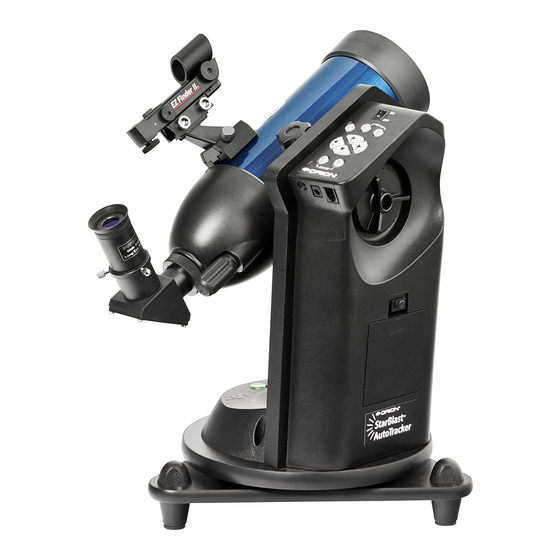
Table of Contents
Advertisement
Quick Links
Advertisement
Table of Contents

Summary of Contents for ORION TELESCOPES & BINOCULARS StarBlast AutoTracker 8983
- Page 1 inSTrucTiOn MAnuAl Orion StarBlast 80mm ® ™ AutoTracker ™ #8983 OrionTelescopes.com Customer Support (800) 676-1343 E-mail: support@telescope.com Corporate Offices (831) 763-7000 89 Hangar Way, Watsonville, CA 95076 Providing Exceptional Consumer Optical Products Since 1975 IN 488 Rev. A 05/13...
-
Page 2: Parts List
introduction Congratulations on your purchase of the Orion StarBlast tele- scope! Take time to read through this manual before embarking on your journey through the heavens. Please read the separate AutoTracker Mount Manual (IN 489) for all information relating to the mount and its accessories. Your StarBlast telescope is designed to give you years of fun and exciting astronomical observations. - Page 3 Focusing Using the lower power eyepiece (25mm) inserted and secured with the thumbscrews, aim the optical tube so the front end is pointing in the general direction of an object at least 1/4- mile away. With your fingers, slowly rotate the focus knob until the object comes into sharp focus.
-
Page 4: Telescope Basics
350mm Once aligned, EZ Finder II will usually hold its alignment even = 14x after being removed and remounted. Otherwise, only minimal 25mm realignment will be needed. At the end of your observing ses- The magnification provided by the 10mm eyepiece is: sion, be sure to turn off the power knob on the EZ Finder II. -
Page 5: Celestial Observing
Observing the Sun • Never look across or over objects that are radiating heat Although overlooked by many amateur astronomers, solar waves. This includes asphalt parking lots on hot summer days or building rooftops. observation is both rewarding and fun. However, because the Sun is so bright, special precautions must be taken when •... -
Page 6: Telescope Maintenance
Specifications Sky Illumination General sky brightening caused by the Moon, aurorae, natural Optical Diameter: 80mm diameter airglow, and light pollution greatly affects transparency. While not a problem for the brighter stars and planets, bright skies Focal Length: 350mm reduce the contrast of extended nebulae making them dif- Focal Ratio: f/4.3 ficult, if not impossible, to see. - Page 7 horizon) and the vertical line containing the celestial body With 31,557,600 seconds in a year, the light-year equals a distance of 9.46 X 1 trillion km (5.87 X 1 trillion mi). whose position is to be measured. . Binary Stars: Binary (Double) stars are pairs of stars that, Magnitude: Magnitude is a measure of the brightness of a because of their mutual gravitational attraction, orbit celestial body.
-
Page 8: Time Zones
Time Zones... - Page 10 Sky Maps...
-
Page 16: One-Year Limited Warranty
Parfocal: Refers to a group of eyepieces that all require the same distance from the focal plane of the telescope to be Terminator: The boundary line between the light and dark in focus. This means when you focus one parfocal eye- portion of the moon or a planet.













Need help?
Do you have a question about the StarBlast AutoTracker 8983 and is the answer not in the manual?
Questions and answers